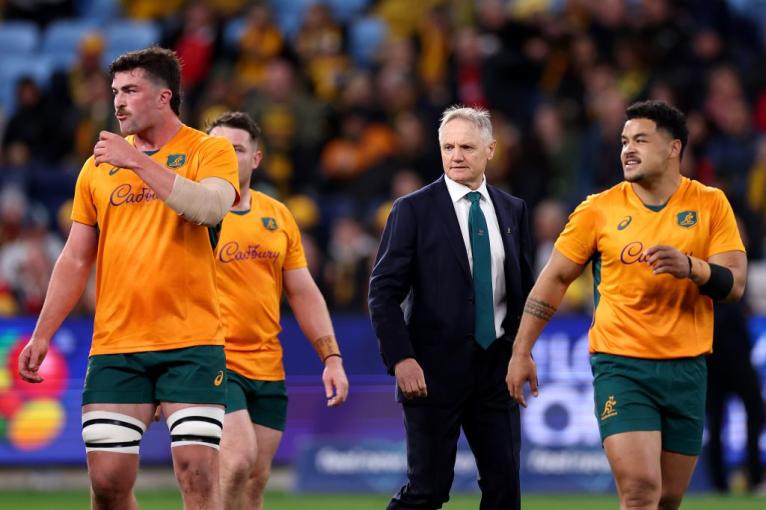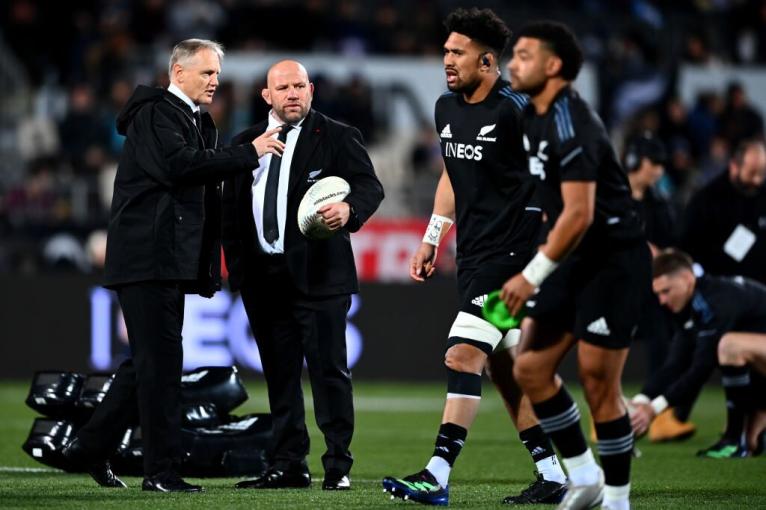There will be hugs, for sure. Maybe not a group love-in worthy of King Charles III and the Black Ferns, but nonetheless, warm smiles and warmer embraces between two coaching staffs run by Kiwis. That is the state of the Bledisloe Cup right now. It is a contest between native, dyed-in the-wool Kiwis and the New Zealand interpretation of a revived Australia.
The head coach of the Wallabies, Joe Schmidt, was a key member of Ian Foster’s coaching group until the World Cup as recently as 10 months ago. He appointed Mike Cron as his scrum and set-piece expert, and ‘Cronno’ was previously associated with the hugely successful All Black teams of Sir Graham Henry and Sir Steve Hansen.

One Aussie on a five-coach panel is not a great advertisement for a nation which had coaching talent spilling out of its ears in the late 1990s and early 2000s, with Rod Macqueen, John Muggleton and Eddie Jones global thought-leaders and innovators in their chosen fields. On the British and Irish Lions tour of 2001, they even had a future national performance director, Scott Johnson, scuttling along the sideline, scribbling down the Lions’ lineout calls on his notepad.
That is ancient history now. Twenty-five years later, it has reached the stage where their trans-Tasman neighbours have been invited over the hedge and into the bosom of the house, to cure the ills of Australian rugby. The bitterest of rivalries has been temporarily put aside in the interests of resuscitating an ailing patient.
Eight of the 11 coaches involved know each other intimately, they understand every personality trait and every coaching tendency. The tone of mutual admiration is too hard to miss and there is a distinct impression they all belong to the same exclusive club. That shared past is cast in solid bronze.
As Scott Robertson’s forwards coach Jason Ryan commented recently:

“It is New Zealand coaches, isn’t it? I enjoyed working with Joe [Schmidt], and obviously Cronno’s been a mentor [of mine] for a while.
“Probably, [I] didn’t think he’d be coaching Australia, to be fair. But one thing I really respected about Cronno is [that] he rung and told me.
“He gave me the heads up before it went public, and I really respect him about that.
“The All Blacks have been a massive part of his life. I guess it’s the coaching world, isn’t it? We are in a game where you just don’t know what’s next. But I have got the utmost respect for both of them.”
How is possible to observe the disparity in quality of coaching between Australia and New Zealand? Take a look at three players who have plied their trade in both countries.
Colossal Fijian wing Nemani Nadolo was cut from the Waratahs 14 years ago, after representing Australia at Under-20s level. He was written off as ‘not Super Rugby standard’ and ‘too big to play the position’ of wing as a mere 21-year-old, despite being hailed as ‘the new Jonah [Lomu]’ by his club coach at Randwick, Mark Giacheri.
“I was told I was too big, or I wasn’t good enough and it was a real driving factor,” Nadolo told RugbyPass. “I played with a bit of a chip on my shoulder. It wasn’t until I went to the Crusaders that I found a coach and an organisation who believed in what I had got [to offer].
“They told me, ‘We know you’re not going to be the quickest or the fittest, but you are going to be the strongest. And you’re quick for your size.’ And that’s when my career took off. That’s where it all started. One thing about New Zealand is they cater for all shapes and sizes.”
In his three seasons with the Crusaders [2014-16], and over the following four years in France with Montpellier [2016-2020], Nadolo developed into probably the most powerful and influential wing in world rugby. When he returned to New South Wales in 2022, it was not without a winsome sense of irony: “Who would’ve thought after leaving these doors 12 years ago I’d get another opportunity to be part of the club again?” Nadolo made only four appearances for the Waratahs before retiring.
Why did Nadolo never go on to represent Australia at senior level? The poor talent identification and development which led to his departure is symbolic of how Aussie has missed the boat for most of the last 20 years. You can sprinkle the names of tight-head props Angus Ta’avao and Tyrel Lomax in the same sad pot.
“Now I cut grass, do gardens, cut hedges for a living…”
– EXCLUSIVE INTERVIEW: @fijirugby legend Nemani Nadolo, with Liam Heagney 👨💻, on retirement, why @crusadersrugby was the making of his stellar career. #SuperRugbyPacific
Click below for more ⤵️https://t.co/Hd3lZlz55n
— RugbyPass (@RugbyPass) April 21, 2024
The 2017 season was a tipping point for tight-heads who might have represented the Wallabies, but crossed the ditch to pull on the silver fern instead. Ta’avao was released in 2017 after two Super Rugby seasons in New South Wales, only to earn an All Blacks debut in his first year with the Chiefs. He went on to anchor the New Zealand scrum on 22 occasions.
Canberra-born Lomax walked away from the Melbourne Rebels franchise in the same year, after playing for the Australia U20s like Nadolo. As with Ta’avao, he was in the All Blacks within 12 months and is now the undisputed anchor of the national scrum, 38 caps later. His performances in the double-header against South Africa suggest he may already have risen to the top of a prestigious pile, as the best tight-head in the business.
Unsurprisingly, Ryan is already planning to turn his prime ‘Aussie’ weapon around, and train it on the Wallabies: “The [next step] for the All Blacks has got to be forward, and against the Australian pack it will need to be around our scrum. I believe we can get a little bit more out of that.”
Ryan’s coaching can be largely credited for the turnaround in Lomax’s international career, which looked to be under terminal threat after he gave up five penalties to his likely opponent this Saturday, Angus Bell, in a Super Rugby match between the Waratahs and the Hurricanes back in 2022.
The moment of truth for Lomax in the 2024 Rugby Championship arrived in the third minute of the second game between South Africa and New Zealand in Cape Town.

The All Blacks had already been all but pushed off their first heel, and the Springboks do not have the kind of scrummage which takes it easy when it smells blood in the water. When you see a tight-head lock’s head appear above the level of his prop’s backside like Tupou Vaai’i’s, there can be only trouble ahead. In the second scrum it materialises fully, with Ox Nche lifting Lomax and the All Blacks set-piece disintegrating.
By the end of the first quarter, turnaround Tyrel had all the technical bases covered and all the problems sorted. and was determined to show the most destructive loose-head in world rugby who was the real master on the day.
The Springboks are again looking for a long scrum and a second shove, but this time it is Nche’s turn to give way on the far side of the South African front row.
Two more set-pieces in the later stages of the half confirmed that first impression.
South Africa is looking to walk the scrum around Nche in the first instance, and drive through him in the second, but in both cases it is Lomax who holds the trump card: knitting the All Blacks’ scrum together for longer as New Zealand finish both set-pieces as the more cohesive, forward-looking eight. After two scrums the home crowd were delirious, for the remainder of the game they were hushed in awe at Lomax’s Herculean comeback. It was some performance, mentally and physically.
With Vaai’i offering better lineout control and more mobility around the paddock [28 involvements on the carry and in the tackle at Cape Town, first among all Kiwi tight forwards] and Tamaiti Williams finally planting his flag in the sand at Test level, the All Blacks tight five is beginning to look the business.
Lomax’s contributions did not end at the set-piece. He showed intelligent ‘hands and feet’ on the carry of which his father John [a rugby league international prop for New Zealand] would have been proud.
The burly prop even made time for a couple of crucial interventions at the defensive breakdown.
The first steal is a ‘singleton’, the second part of a double jackal with Sam Cane, which attracts the extra cleanout player and forces a fumble on the next pass by Kwagga Smith.
The paradoxical nature of New Zealand’s support for Australian rugby will lift to an entirely new level with Schmidt now working in opposition to at least one coach [Ryan] who was a comrade-in-arms less than a year ago. Can Schmidt and ‘Cronno’ really have any surprises concealed for antagonists who know them so well? Can ‘New Zealand-Lite’ beat the All Blacks at their own game?
The prospect seems the more remote, when you consider the trio of Nadolo, Ta’avao and Lomax might have worn the green and gold – and two of them did indeed represent Australia at junior level – but all three had to return to New Zealand to discover their true worth as professionals.
Australia either failed to recognise their value or neglected to develop it. There will be an all-consuming, All Black hug when the smoke clears and the battle is over in Sydney this Saturday, but it is becoming ever harder to distinguish the dagger from the Kiwi embrace, through the fog of war.


REpost:
Great fightback by Australia, some good running from midfield, and even set peice, surprisingly, got them back in that one.
Much like the England series, hell the season so far, fairly flattering to the All Blacks opposition really!
See new article for their lineout attack!
I was a bit worried I spoke too soon, but they pulled it back nicely. Theyre speaking more and more about how to take advantage of it, after Argentina no doubt, aren't they? Locks, with the rookie feeding it and rookie on the blindside unable to help Barrett channel the ball, let them down in the first couple, didn't they?
Plenty of redemption stories everywhere. New Zealand wasn't able to turn Will Skeltons larger brother into the same level of player, and I don't think they would have done as well with Will, either. NZ is just in it for props. NZ appreciates that contest more because of their rivalry with South Africa, so they are always keen on scrummagers, and their was something about that Chiefs environment as well, it was a rough few years were Big Karl also got the opportunity to impress (Charlie left?).
I've been critical of Lomax's feet in the D line Nick, he just seems to like to shuffle, over reliant on the the slide and his insides. He needs to cut it out, I suggest linebacker rush training and just exploding forward every time, no matter what.
We're in it together.
Thanks for the article.
Cahrlie Famuaina went to Toulouse and I believe big Karl is still in France too...
So Nick any ideas on how to fix this? For years our development, coaching, recruitment etc has been poor. The evidence in this article is confronting but also not the first one of its kind. You can't blame one administrator and P Waugh seems genuine in trying to fix things...but I'm not sure the top dogs in Oz really see how bad it is?? As long as the Traditional areas and schools keep playing i don't think they care if we lose another Nadolo or Lomax
I think the answer has to be at university level, together with Japan.
I don't know the infrastructure of Aussie rugby deeply enough DW. Someone like Brett might knows the ins and outs of it. But is hard to know why the quality in these three players, and Will Skelton who is not a Kiwi, was never acknowledged or developed.
Add Mack Hansen to that list. Hansen was playing for Ireland less than 12 months after leaving the Brums, so he must already have had those Test-match qualities within him in Aussie. But he was never seen as such at home.
A tighthead prop who outside the scrum operates like a loose head. He reminds me of a more compact version of Thomas du Toit - though much better hands :) It is always an asset to be able to pack both sides. Really an insurance against a double injury on one side of the scrum.
I don't know if Tyrel can play LHP Graham - although the 'Tank' certainly can play both sides and equally well!
On the road (IoM this am), still have not seen any RC games in full. So your clips Nick are all I have seen of the scrummaging. That is a very impressive turnaround. Actually reminds of a similar case in a Munster v Clermont game a few years ago. Article on it on another site "The dangerous scrum behaviour rugby must work harder to outlaw"
Lomax is following the trajectory of many great props. As they mature they really peak. At now 28, Lomax ios into that sweet spot age bracket. It will be interesting to compare him with Taniela in the upcoming games. I would think Lomax will be ahead.
I will be watching with interest how Angus Bell copes with Lomax. I'm still not fully sold on Bell as a scruammager. Rest of his game is rising to world class.
I remember that piece Miz!
Any prop who can make the fix at that level has to be admired. It wasn't going to come from the other side where Tamaiti is learning the ropes, but it did come from Lomax. And against Nche of all people.
Look at those 2nd half scrums, the Ox is almost compliant!